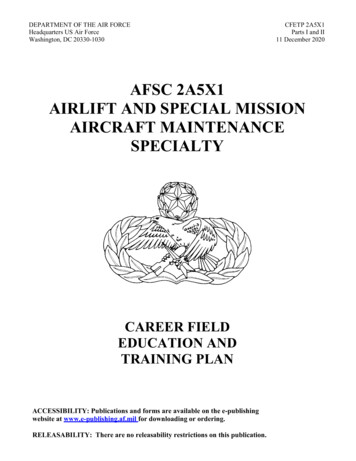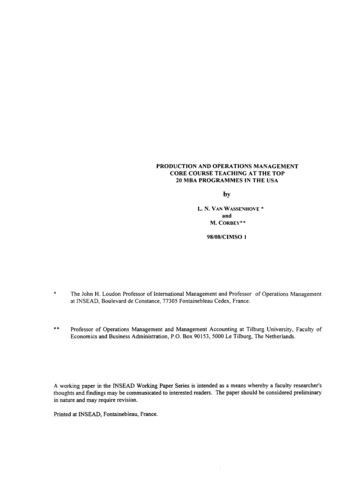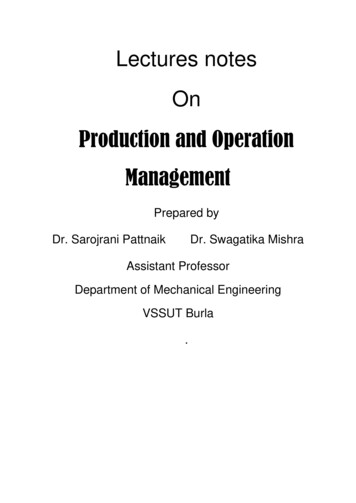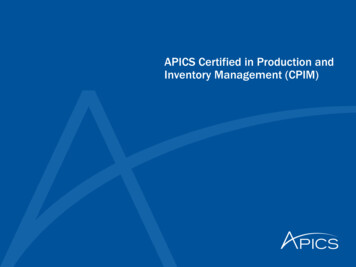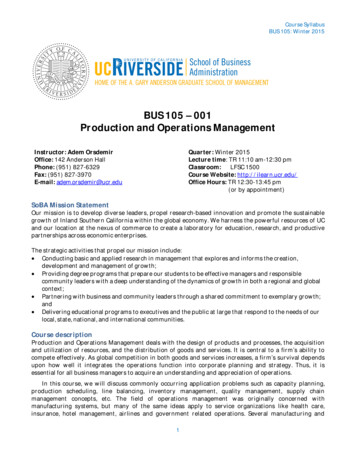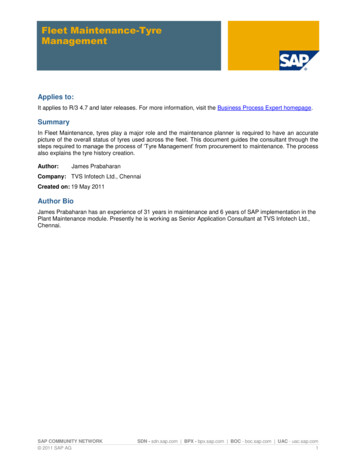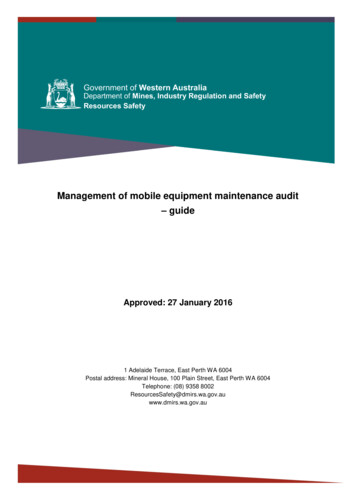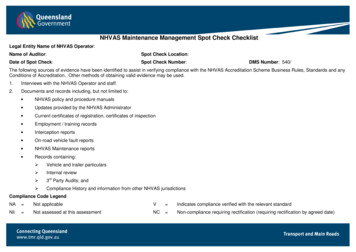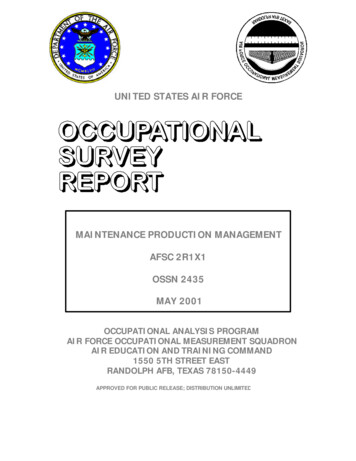
Transcription
UNITED STATES AIR FORCEMAINTENANCE PRODUCTION MANAGEMENTAFSC 2R1X1OSSN 2435MAY 2001OCCUPATIONAL ANALYSIS PROGRAMAIR FORCE OCCUPATIONAL MEASUREMENT SQUADRONAIR EDUCATION AND TRAINING COMMAND1550 5TH STREET EASTRANDOLPH AFB, TEXAS 78150-4449APPROVED FOR PUBLIC RELEASE; DISTRIBUTION UNLIMITED
Form SF298 Citation DataReport Date("DD MON YYYY")01052001Report TypeN/ADates Covered (from. to)("DD MON YYYY")Title and SubtitleUnited States Air Force Occupational Survey ReportMaintenance Production Management AFSC 2R1X1-OSSN2435Contract or Grant NumberAuthorsProject NumberProgram Element NumberTask NumberWork Unit NumberPerforming Organization Name(s) and Address(es)Occupational Analysis Program Air Force OccupationalMeasurement Squadron Air Education and Training Command1550 5TH Street East Randolph AFB, Texas 78150-4449Performing OrganizationNumber(s)Sponsoring/Monitoring Agency Name(s) and Address(es)Monitoring Agency AcronymMonitoring Agency ReportNumber(s)Distribution/Availability StatementApproved for public release, distribution unlimitedSupplementary NotesAbstractSubject TermsDocument ClassificationunclassifiedClassification of SF298unclassifiedClassification of AbstractunclassifiedLimitation of AbstractunlimitedNumber of Pages94
DISTRIBUTION FOR AFSC 2R1X1 OSRAFOMS/OMYXICCAF/DFAXDEFENSE TECHNICAL INFORMATION CENTERHQ AFPC/DPAAD4HQ AFPC/DPPACUSMC TRAINING AND EDUCATION, STANDARDS BRANCHHQ AETC/DOOHQ ACC/DPPEHQ AETC/DPSEHQ AFMC/DPEEHQ AFSOC/DPPMTHQ AMC/DPPETHQ PACAF/DPPET86 MSS/DPMATHQ AFRC/DPTSHQ USAF/ILMM362 TRS/TRR (613 10TH AVE, SHEPPARD AFB TX, 76311-2352)82 TRG/TTS (620 9TH AVE, STE 1, SHEPPARD AFB TX, 76311-2334)ii212111133333335131
TABLE OF CONTENTSPAGENUMBERPREFACE.viiSUMMARY OF RESULTS .ixINTRODUCTION.1Background.1SURVEY METHODOLOGY.2Inventory Development.2Survey Administration.2Survey Sample .3Task Factor Administration.3SPECIALTY JOBS.6Overview of Specialty Jobs.6Group Descriptions .9Comparison of Current Jobs to Previous Survey Findings.16Summary.23ANALYSIS OF DAFSC GROUPS.23Active Duty Skill-Level Descriptions.23Air National Guard Skill-Level Descriptions .24Air Force Reserve Skill-Level Descriptions .25Summary.26TRAINING ANALYSIS .26First-Enlistment Personnel.26Training Emphasis (TE) and Task Difficulty (TD) Data.28Specialty Training Standard (STS).28Plan of Instruction (POI).29JOB SATISFACTION ANALYSIS.29IMPLICATIONS .31iii
THIS PAGE INTENTIONALLY LEFT BLANKiv
TABLE OF CONTENTS(Tables, Figures, Appendices)PAGENUMBERTABLE 1 MAJCOM DISTRIBUTION OF AFSC 2R1X1 PERSONNEL. 4TABLE 2 PAYGRADE DISTRIBUTION OF SURVEY SAMPLE. 5TABLE 3 AVERAGE PERCENT TIME SPENT ON DUTIES BY AD CAREERLADDER JOBS.17TABLE 4 SELECTED BACKGROUND DATA FOR SPECIALTY CLUSTERSAND JOBS.20TABLE 5 SPECIALTY JOB COMPARISONS BETWEEN CURRENT AND1998 SURVEY.22FIGURE 1 AFSC 2R1X1 SPECIALTY JOBS (N 986). 8FIGURE 2 AFSC 2R1X1 AD FIRST ENLISTMENT SPECIALTY JOBS (N 178). 27APPENDIX A SELECTED REPRESENTATIVE TASKS PERFORMED BY MEMBERSOF CAREER LADDER JOBS.33APPENDIX B TABLE 6-41 . 35v
THIS PAGE INTENTIONALLY LEFT BLANKvi
PREFACEThis report presents the results of an Air Force Occupational Survey of the MaintenanceProduction Management career ladder, Air Force Specialty Code (AFSC) 2R1X1. Authority forconducting occupational surveys is contained in AFI 36-2623. Computer products used in thisreport are available for use by operations and training officials.The survey instrument was developed by Lieutenant Tyson Freking, Inventory DevelopmentSpecialist, with computer programming support furnished by Mr. Tyrone Hill and administrativesupport provided by Ms. Dolores Navarro. Dr. Burke Burright, Occupational Analyst, analyzedthe data and wrote the final report. This report has been reviewed and approved by LieutenantColonel Roger W. Barnes, Chief, Airman Analysis Section, Occupational Analysis Flight, AirForce Occupational Measurement Squadron (AFOMS).Copies of CD ROMs containing this report and associated data extracts and briefings aredistributed to Air Staff sections, major commands, and other interested training and managementpersonnel. Additional copies are available upon request to AFOMS/OMYXI, 1550 5th StreetEast, Randolph Air Force Base, Texas 78150-4449, or by calling DSN 487-5543. Forinformation on the Air Force occupational survey process or other on-going projects, visit ourweb site at http://www.omsq.af.mil.JAMES M. COLLINS, Lt Col, USAFCommanderAir Force Occupational Measurement SqJOHN L. KAMMRATHChief, Occupational Analysis FlightAir Force Occupational Measurement Sqvii
THIS PAGE INTENTIONALLY LEFT BLANKviii
SUMMARY OF RESULTS1. Survey Coverage: The Maintenance Production Management career ladder was surveyedto obtain current task data for use in evaluating current training programs. Survey results arebased on 986 responses (62 percent of the total assigned personnel). The survey samplerepresents the overall career ladder population satisfactorily.2. Specialty Jobs: The analysis identified two clusters of jobs and seven independent ones.One large cluster is directly involved in performing core duties and tasks; a second, smallercluster contained a set of narrowly defined entry-level jobs.The Maintenance Production Management career field has experienced only minor changesin its job structure since the previous survey in 1998. All the clusters and jobs identified in the1998 OSR can be matched to similar jobs identified in the 2001 report. However, this reportidentified two additional jobs, the Training Job and the Command-level Manager Job, that hadnot been documented in the earlier report.3. DAFSC Groups: A typical career ladder progression within the AFSC 2R1X1 careerladder is evident in the Active Force, with the 3- and 5-skill level airmen focusing on technicaltasks. The Active Duty (AD) 5-skill level group starts to take on some management,supervisory, and training tasks. Although AD members at the 7-skill level continue to devote amajority of their time to technical tasks, almost 40 percent of it is devoted to management,supervisory, and training tasks. The AD 9-skill level group has a heavy focus on management,supervisory, and training activities.Career ladder progression is different for AFSC 2R1X1 members in the Air NationalGuard (ANG) and Air Force Reserve Command (AFRC). The reserve services have relativelyfew 3-skill level members. Career ladder progression includes only the 5-, 7-, and 9-skilllevels. Moreover, these ANG and AFRC 7- and 9-skill level members remain much morefocused on technical tasks than do their counterparts in the Active Force.4. Training Analysis: The tasks performed by AD members during their first enlistment arehighly technical in nature. A comprehensive review of the Specialty Training Standard (STS)found that most paragraphs were supported by the survey data. However, five items in the STSwere associated with tasks with less than the recommended percent members performing. Onetask not referenced in the STS exceeded the minimum number required for inclusion.Review of the tasks matched to the Plan of Instruction (POI) for the apprentice courserevealed that two of its learning objectives were not supported by OSR data. On the other hand,seven technical tasks performed by over 30 percent of first-enlistment personnel were notincluded in the POI. These areas should be reviewed to determine whether any modifications areneeded to improve the effectiveness or efficiency of training.5. Job Satisfaction Analysis: Analysis showed that during their first two enlistments, 2R1X1members indicated higher levels of job satisfaction than did members in similar career fields.Moreover, they did not experience a decline in most facets of job satisfaction since the lastix
survey, as many indicators actually improved. The analysis did highlight the Reserve ForcesProduction Control Job and the TMDE Scheduling Job as two small groups with lower levels ofjob satisfaction.6. Implications: Survey data show the AFMAN 36-2108 Specialty Description accuratelyreflects the jobs and tasks currently being performed in the career ladder. The analyses of theSTS and the POI identified unsupported paragraphs and learning objectives. It also identifiedtasks not referenced in the documents that were being performed by enough members towarrant inclusion. The unsupported areas and the non-referenced tasks should be reviewed todetermine if their inclusion in future revisions of these documents is warranted.x
OCCUPATIONAL SURVEY REPORT (OSR)MAINTENANCE PRODUCTION MANAGEMENT(AFSC 2R1X1)INTRODUCTIONThis is a report of an occupational survey of the Maintenance Production Management(AFSC 2R1X1) career ladder completed by the Air Force Occupational Measurement Squadron(AFOMS). These data will be utilized to review the AFMAN 36-2108 Specialty Description andtraining documents. The last OSR was published in July 1998.BackgroundAs described in the AFMAN 36-2108 Specialty Description, dated 3l October 2000,members of the 2R1X1 plan, schedule, and organize the use and maintenance of aircraft,engines, munitions, and associated aerospace ground equipment (AGE). They also documentand maintain aircraft, missiles, munitions, and associated AGE records, develop generation flowplans to meet emergency war order and wartime tasking, and analyze maintenance informationand monitor maintenance management scheduling effectiveness.Entry into the career ladder currently requires an Armed Services Vocational AptitudeBattery score of General 43. Personnel entering the AFSC 2R1X1 career ladder must attend a 6week and 1-day Maintenance Production Management Course conducted at Sheppard AFB TX.This consists of familiarization of aircraft maintenance organizations, concepts andresponsibilities. It provides an introduction to scheduling aerospace vehicles and to schedulingand monitoring work requirements. It also covers maintaining automated information systemsand weapon system recordsAPPROVED FOR PUBLIC RELEASE; DISTRIBUTION UNLIMITED1
SURVEY METHODOLOGYInventory DevelopmentThe data collection instrument for this occupational survey was USAF Job Inventory (JI),Occupational Survey Number 2435, dated May 2000. A tentative task list was prepared afterreviewing pertinent career ladder publications and directives, pertinent tasks from the previoussurvey instrument, and data from the last OSR. The preliminary task list was refined andvalidated through personal interviews with 27 subject-matter experts (SMEs) at the technicaltraining location and at the following operational bases:BASEUNIT VISITEDSheppard AFB, TX362nd TRS/TOCEglin AFB, FL60th FSMcCord AFB, WA62nd LGMcConnell AFB, KS22nd MSGKelly AFB, TX149th LSFThe resulting JI contains a comprehensive listing of 231 tasks grouped under 10 dutyheadings and a background section requesting such information as base of assignment, commandof assignment, Air Force component status, organizational level, job title, computer softwareused, and automated management system used.Survey AdministrationFrom May through Aug 2000, Base Training Offices administered the inventory to 1484eligible AFSC 2R1X1 personnel. To qualify for the survey, personnel were required to hold aduty AFSC of 2R131, 2R151, 2R171, or 2R191. Excluded from the survey were personnel inPCS, student, or hospital status, or with less than 6 weeks on the job. Job incumbents wereselected from a computer-generated mailing list obtained from personnel data tapes maintainedby the Air Force Personnel Center, Randolph AFB TX.Each individual who completed the inventory first completed the identification andbiographical information section and then checked each task performed in his or her current job.After checking all tasks performed, each member then rated each of these tasks on a 9-pointscale, showing relative time spent on that task, as compared to all other tasks checked. Theratings ranged from 1 (very small amount time spent) through 5 (about average time spent) to 9(very large amount time spent).2
To determine relative time spent for each task checked by a respondent, all of theincumbent's ratings are assumed to account for 100 percent of his or her time spent on the joband are summed. Each task rating is then divided by the total task ratings and multiplied by 100to provide a relative percentage of time spent for each task. This procedure provides a basis forcomparing tasks in terms of both percent members performing and average percent time spent.Survey SamplePersonnel were selected to participate in this survey to ensure an accurate representationacross major commands (MAJCOMs) and paygrade groups. All eligible AFSC 2R1X1personnel were mailed survey booklets. Table 1 reflects the percentage distribution, byMAJCOM, of assigned AFSC 2R1X1 personnel as of May 2000. The 986 respondents in thefinal sample represent 62 percent of the total assigned personnel. Table 2 reflects the paygradedistribution for these AFSC 2R1X1 personnel. The survey sample reflects closely the careerladder population.Task Factor AdministrationJob descriptions alone do not provide sufficient data for making decisions about careerladder documents or training programs. Task factor information is needed for a completeanalysis of the career ladder. While most participants in the survey process completed a USAFJI, selected senior AFSC 2R1X1 personnel were also asked to complete booklets renderingjudgments on task training emphasis (TE) or task difficulty (TD). The TE and TD booklets wereprocessed separately from the JIs. The information gained from these task factor data is used invarious analyses and is a valuable part of the training decision process.Training Emphasis (TE). TE is a rating of the amount of emphasis that should be placed ontasks in entry-level training. The 51 senior AFSC 2R1X1 NCOs who completed a TE bookletwere asked to select tasks they felt required some sort of structured training for entry-levelpersonnel and then indicate how much training emphasis these tasks should receive, from 1(extremely low emphasis) to 9 (extremely high emphasis). Structured training is defined astraining provided at resident technical schools, field training detachments (FTDs), mobiletraining teams (MTTs), formal on-the-job-training (OJT), or any other organized trainingmethod. The inter-rater reliability was excellent, indicating very strong agreement among the 51raters as to which tasks required some form of structured training and which did not. Theaverage TE rating was 2.68, with a standard deviation of 1.84. Any task with a TE rating of 4.52or above is considered to have high TE.Task Difficulty (TD). TD is an estimate of the amount of time needed to learn how to do eachtask satisfactorily. The 47 senior NCOs who completed TD booklets were asked to rate thedifficulty of each task using a 9-point scale (extremely low to extremely high). Inter-raterreliability was acceptable, with high agreement. Ratings were standardized, so tasks have anaverage difficulty of 5.00 and a standard deviation of 1.00. Any task with a TD rating of 6.00 orabove is considered difficult to learn.3
TABLE 1MAJCOM DISTRIBUTION OF AFSC 2R1X1 PERSONNELCOMMANDPERCENT OFASSIGNED*PERCENT FMC22Other AD11AG2721 AFRC1212Total AssignedTotal Eligible for SurveyTotal Surveyed in SamplePercent of Assigned in SamplePercent of Eligible in Sample1,587 *145298662%68%*As of May 2000.4
TABLE 2PAYGRADE DISTRIBUTION OF SURVEY SAMPLEPERCENT OFASSIGNED*PERCENT OFSAMPLEE-1 to ADE* As of May 20005
When used in conjunction with the primary criterion of percent members performing, TE and TDratings can provide insight into first-enlistment personnel training requirements. Such insightsmay suggest a need for lengthening or shortening portions of instruction supporting entry-leveljobs.SPECIALTY JOBSThe first step in the analysis process is to identify the structure of the career ladder in termsof the jobs performed by the respondents. Comprehensive Occupational Data Analysis Programs(CODAP) assist by creating an individual job description for each respondent based on the tasksperformed and relative amount of time spent on the tasks. The CODAP automated j
Review of the tasks matched to the Plan of Instruction (POI) for the apprentice course revealed that two of its learning objectives were not supported by OSR data. On the other hand, seven technical tasks performed by over 30 percent of
